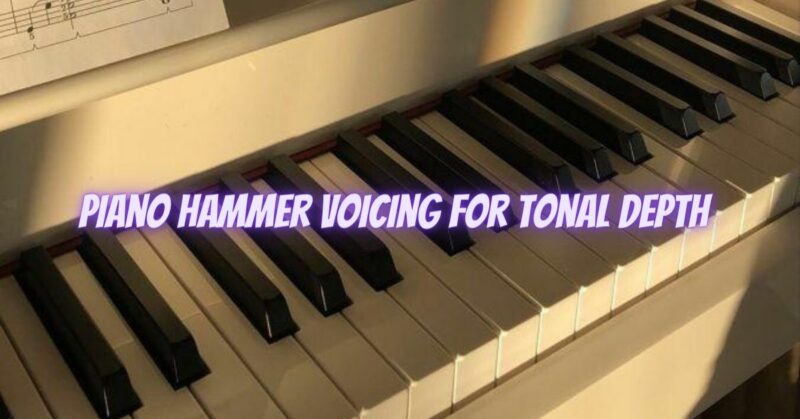Tonal depth is a fundamental characteristic of a piano’s sound that allows it to resonate and project rich, warm, and expressive tones. When voicing piano hammers for tonal depth, the goal is to achieve a deep and full-bodied sound that captivates the listener with its richness and complexity. This involves shaping the hammers to produce a broad spectrum of overtones and harmonics, creating a sense of depth and richness in the sound. Here are some essential techniques for voicing piano hammers to achieve tonal depth:
- Hammer Felt Selection: The choice of hammer felt significantly influences tonal depth. Pianists often opt for softer felt materials that allow the hammers to create a warmer and more resonant tone. Softer felt enables the hammers to generate more harmonic content, resulting in a deep and complex sound.
- Voicing Technique: To achieve tonal depth, the hammers are carefully shaped to have a rounded and more convex striking surface. This shape enables the hammers to produce a broader range of harmonics when striking the strings, resulting in a lush and layered sound.
- Voicing Gradation: Voicing for tonal depth requires a delicate balance between softness and firmness in the hammer felt. Skilled technicians use various voicing needles and tools to adjust specific sections of the hammer felt, creating a gradation of tonal depth across the keyboard. This allows for a more nuanced and expressive sound in different registers of the piano.
- Regulation of Key Action: Proper regulation of the piano’s key action is crucial for achieving tonal depth. The alignment and timing of various components are adjusted to ensure that the hammers strike the strings uniformly and with the desired depth of sound.
- Dynamic Expression: Tonal depth should also be present across a wide range of dynamic levels. Pianists aim to maintain the richness and fullness of the sound, whether playing softly or loudly. This requires voicing the hammers to respond consistently across all dynamic ranges.
- Listening and Refinement: Achieving tonal depth is an iterative process that involves attentive listening and constant refinement. Pianists carefully assess the sound and adjust the hammer voicing to achieve the desired tonal qualities. The process may require several iterations to achieve the perfect tonal depth.
- Regular Maintenance: Regular maintenance and voicing adjustments by a skilled piano technician are essential for maintaining tonal depth over time. As hammers compact and wear with use, their voicing may change, affecting the depth of the piano’s sound. Regular voicing ensures that the piano retains its tonal depth and richness.
- Synergy with the Piano’s Design: Tonal depth is influenced not only by hammer voicing but also by the piano’s overall design and construction. Each piano model has its unique characteristics, and the voicing process should consider these factors. A collaborative approach between the pianist and the piano technician ensures that the voicing aligns with the piano’s design for optimal tonal depth.
In conclusion, voicing piano hammers for tonal depth is a meticulous process that requires a deep understanding of the piano’s construction and a keen ear for tonal nuances. By selecting the appropriate hammer felt, using specific voicing techniques, and regulating the key action, pianists can achieve a rich and expressive sound with tonal depth. Regular maintenance and collaboration with a skilled piano technician ensure that the piano maintains its tonal depth over time. With a well-voiced piano that offers a deep and resonant sound, pianists can convey emotion and artistry through their performances, captivating audiences with the beauty and complexity of the music.


